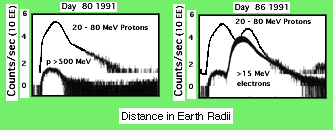|
(Files in red–history) |
The artificial radiation belts from the Argus experiment were located in the "slot" between the two belts and their lifetimes of a few weeks underscored the temporary nature of trapping there (especially for electrons produced just above the atmosphere). In October-November the USSR exploded three rather large bombs in space, in the outer belt region, and their electrons also persisted for a number of weeks. On the other hand, the "Starfish" H-bomb test, conducted by the USAir Force in July 1962 above Johnston Island west of Hawaii, injected high-energy electrons into the stable inner radiation belt, many of them lasting a year or two, some even longer. The intense artificial radiation belt from that blast disabled three satellites. Nuclear explosions in space were banned in 1967 by an international treaty, but nature itself sometimes steps in. On March 24, 1991 a strong interplanetary shock, originating on the Sun, hit the Earth's atmosphere, compressed it greatly and sent a secondary shock through its interior. Like surfers riding a wave, trapped electrons and ions rode this shock and within a minute or so created a new radiation belt just outside the inner belt (picture below). The new belt contained both electrons and protons of high energy (15-20 Mev), and it disabled the MARECS-I satellite and degraded GOES-7. The new belt was observed by the US Air Force satellite CRRES and was still in place (somewhat weakened) when CRRES stopped transmitting at the end of 1991. For a more complete story, click here.
|
